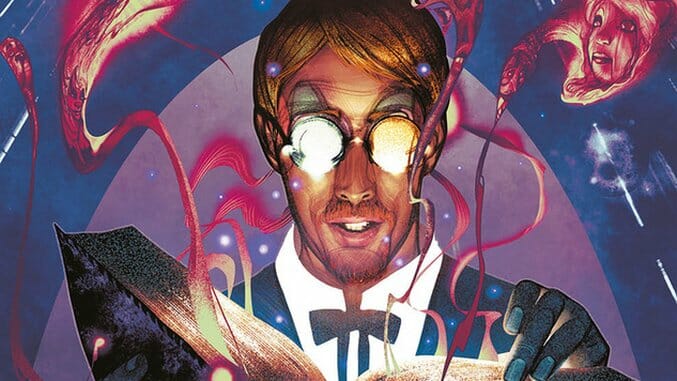One Week in the Library Scribe W. Maxwell Prince Talks Long Elevator Pitches, Infographics and Borges
Main Art by Frazer Irving
W. Maxwell Prince and John Amor’s original graphic novel, One Week in the Library, is a wild and weird project to describe. Told throughout seven chapters, each named for a day in the week, One Week in the Library is like a cross between the 1994 animated footnote The Pagemaster and the works of Argentine writer Jorge Luis Borges, with a heavy dose of medium-mashing à la Mark Z. Danielewski’s House of Leaves. Paste had the opportunity to talk with Prince over the phone recently about the origins behind the project, his motivations as a writer and the allure of transforming traditional fairytales through a contemporary post-modern lens.

One Week in the Library Cover Art by Frazer Irving
Paste: How would you describe One Week in the Library to someone who’s never heard of it? Give us your elevator pitch.
W. Maxwell Prince: I’ve definitely had some trouble distilling it down into what people call the “elevator pitch.” My best attempt at that is that it’s seven short stories, one for each day of the week. It’s about a librarian in a magical infinite library where every book ever written and ever not written and every variation of every book ever written and not written exists. And basically, each short story is an experiment in a specific type of storytelling, usually mixing comics with some other type of medium, or some other message to show the possibilities of comics and play with the written word in a way an actual library does. I realize that’s the longest elevator pitch that anyone’s ever given [Laughs].
Paste: Both of your releases this year, The Electric Sublime and One Week in the Library, offer two equally meta takes on how the creative act of art and storytelling shape and are shaped by the human experience. What inspired this recent stint of your work?
Prince: I’d say that, for me at least, the way that I construct meaning from experience is often through the filter of art. Some of my most intimate relationships are with art. I read non-stop, I try to read a book a week and I listen to music constantly. I’m using art to place myself in the world, and by “art” I mean in the broad sense of creative works in all these different media, but I definitely use these creations to start to clarify my relationship with the world and how I think and feel about it, especially [now]. The election didn’t go the way I wanted it to go, and I’ve definitely used art as a way to deal with that, whether it’s music or losing myself in a book for an hour or two. So I think a lot of that stems from my intimate relationship with these works and what I tap out of them, which is this great meaning and understanding about myself and about the world and how I want to shape it. It’s not a coincidence to me that the takeaway from those two books is that they center on what it means to make work, or consume work and how that helps you to construct some meaning and understanding about the world.
Paste: While talking with Forbidden Planet about your previous work, 2015’s Judas: The Last Days, you said that your goal was to, “…make something sad, something good and something ‘infinite and intimate.’” Do you believe that you were able to achieve that here with One Week in the Library? What was your goal when you set out to write this book?
Prince: I think maybe this book is more successful at that goal than Judas: The Last Days was. The first thing I wanted to do was make a comic that did not adhere to the conventions of modern comics, starting with something really simple, like page length, and then also the sort of tricks and tools—these great signifiers of comics that we’ve come to understand and subvert. Even if people don’t analyze comics in this way, I think comic writers know that you write for what’s called “the page turn,” meaning you should have some sort of forward momentum or surprise each time the reader turns the page. So in that way, you’re thinking very much about the physical product or the way that serial issues end with a big splash page, with a twist that propels the reader into the next issue and keeps them coming back for more.
I started wanting to see what it would be like to make something that didn’t worry too much about those conventions, and I think my desire to make something “infinite and intimate”—I think what I mean is that I want something to have grand implications with high stakes and a high scope, while also simultaneously being something small and approachable. A story that wiggles its way into you and comes across as both something loud and quiet. I set out basically to make One Week in the Library different, and then my usual motivations when it comes to art made their way into the project, and I think that it uses the idea of the “infinite library” in a way that suggests a ton of possibilities through the stories themselves.

One Week in the Library Interior Art by John Amor
Paste: Many of the stories told throughout the library, including that of One Week in the Library itself, lack what readers would typically describe as a definitive beginning or end. Was this a deliberate choice, or an unconscious result of the writing process?
-

-

-

-

-

-

-

-

-

-

-

-

-

-

-

-

-

-

-

-

-

-

-

-

-

-

-

-

-

-

-

-

-

-

-

-

-

-

-

-











































